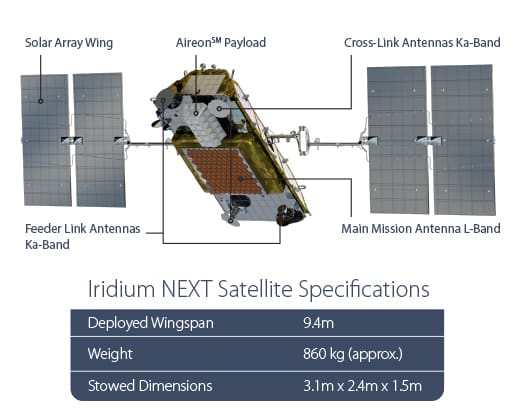The backbone of Aireon’s technology resides on the Iridium constellation of satellites. Eight Iridium NEXT launches on Space-X Falcon 9 rockets successfully occurred between January 2017 and January 2019. Iridium’s next generation satellite constellation will deliver exciting new innovations and opportunities, while ensuring continued high performance and reliability far into the future. To enable the Aireon system, Iridium will host specially designed receivers on each Iridium satellite, covering 100 percent of the globe.
Iridium low-latency, 66 cross-linked Low-Earth Orbit (LEO) satellites make it uniquely suited to meet the technical demands of global air traffic surveillance and tracking. The LEO satellites will orbit approximately 485 miles above the earth and each satellite will be linked to four others, creating a dynamic network to ensure continuous availability, everywhere on the planet.
A Uniquely Sophisticated Architecture
Each Iridium satellite is linked to four others – two in the same orbital plane and one in each adjacent plane – creating a dynamic mesh network that routes traffic among satellites to ensure a continuous connection, everywhere. This unique configuration allows services using the Iridium network to continue to remain unaffected by natural disasters, including hurricanes, tsunamis and earthquakes that can cripple terrestrial infrastructure.
Iridium Constellation Partners
Each of the 66 satellites in the Iridium constellation were built at the Orbital facility in Gilbert, Ariz., in addition to in-orbit and ground spares. The satellites were shipped to the Thales Alenia Space facility in Cannes, France, where it underwent qualification testing to ensure robustness of design.
Iridium and Aireon
Iridium is hosting the Aireon system. It is the only satellite constellation with the capability and reach to enable global air traffic surveillance. This is all due to its orbital configuration. The configuration provides complete global coverage, including oceanic and polar regions, without the need for ground stations. The LEO altitude allows the aircraft signals to be received in space without any additional equipment or changes to the existing aircraft avionics. The intersatellite communications links will enable real-time delivery information to Air Traffic Control (ATC) to support aircraft separation services. No other system, existing or planned, will enable such an opportunity for aviation stakeholders.
